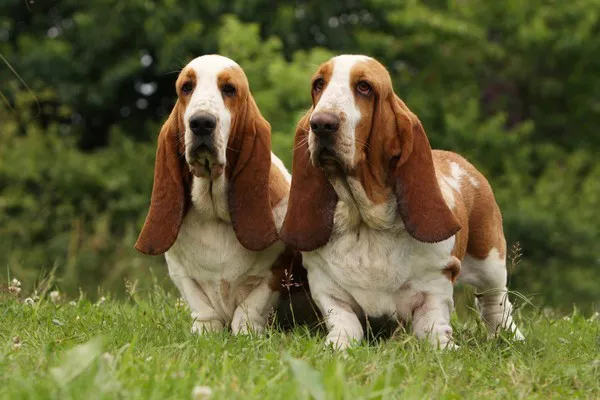Introduction
Basset Hounds, with their soulful eyes, droopy ears, and distinctive elongated bodies, are a beloved dog breed that has captured the hearts of millions worldwide. Originally bred in France for hunting small game, these charming canines have since become popular companions and family pets. In this comprehensive guide, we will explore the unique characteristics and qualities that make Basset Hounds stand out as a breed, covering their history, physical attributes, temperament, intelligence, and popular culture references.
1. The History of Basset Hounds
Basset Hounds have a long and storied history dating back to the 6th century in France. The name “Basset” comes from the French word “bas,” meaning low, which aptly describes their low-set bodies. Originally developed by monks, Basset Hounds were bred for their exceptional sense of smell and ability to track small game, such as rabbits and hares. Their short legs and slow pace made them ideal for trailing scents over long distances, and their distinctive baying was used to alert hunters when prey was located.
2. Physical Attributes and Appearance
Basset Hounds possess several physical attributes that set them apart from other dog breeds. They have a medium to large-sized body with a height between 11 to 15 inches at the shoulder and weigh between 40 to 65 pounds, with males generally larger than females. Their most noticeable feature is their long, droopy ears, which can reach several inches in length and help to sweep scents towards their highly sensitive nose. Their wrinkled face and deeply soulful eyes give them a distinctive and endearing expression that tugs at the heartstrings of dog enthusiasts.
3. Temperament and Personality
One of the most endearing qualities of Basset Hounds is their gentle and laid-back temperament. They are known for being friendly, affectionate, and patient, making them excellent companions for families, including those with children and other pets. Bassets are not typically aggressive and are known for their ability to get along with other dogs, thanks to their pack-hunting history. However, they can be stubborn at times, which can make training a challenge. Consistent, positive reinforcement training methods work best with these intelligent yet independent thinkers.
4. Intelligence and Trainability
Basset Hounds are intelligent dogs, although their stubborn streak can sometimes make training sessions entertaining. Their strong sense of smell can be both a blessing and a curse during training, as they might easily get distracted by scents in the environment. Patience and consistency are key when training Bassets, as harsh methods can lead to avoidance behaviors or even exacerbate their stubbornness. Engaging, reward-based training methods that appeal to their food motivation are effective in keeping them focused and eager to learn.
5. Exercise and Grooming Needs
Despite their laid-back nature, Basset Hounds require regular exercise to maintain a healthy weight and overall well-being. Daily walks and playtime in a secure area are essential for keeping them physically and mentally stimulated. However, it’s crucial to avoid overexertion due to their long bodies and short legs, which can put strain on their joints.
Regarding grooming, Bassets have a short, dense coat that is relatively low-maintenance. Regular brushing will help keep their coat clean and free of loose hair. Additionally, their droopy ears require special attention, as they are prone to ear infections. Regular cleaning and drying of the ears can help prevent potential health issues.
6. Health Considerations
Like all dog breeds, Basset Hounds are prone to certain health conditions that potential owners should be aware of. One of the most common health concerns in Basset Hounds is obesity, which can lead to joint problems and other health issues. Providing a balanced diet and regular exercise is crucial in maintaining their overall health.
Their long ears and wrinkles can also be a breeding ground for infections if not properly cared for. Regular cleaning and checking for any signs of irritation or infection are essential.
Basset Hounds are also predisposed to certain genetic conditions, including hip dysplasia, elbow dysplasia, and glaucoma. Responsible breeders conduct health screenings to minimize the risk of passing on genetic disorders to puppies.
7. Basset Hounds in Popular Culture
The endearing qualities of Basset Hounds have earned them a place in popular culture. From movies and TV shows to advertisements, Bassets have often been cast as lovable and memorable characters. The 1952 film “The Big Sky” featured a Basset Hound named “Mike” as a traveling companion. In the world of literature, the cartoon character “Droopy” is based on the Basset Hound’s distinct appearance and languid demeanor.
In the advertising world, Basset Hounds have been featured in various campaigns, including the famous Hush Puppies shoe commercials. Their charming looks and amiable personality continue to make them appealing to audiences of all ages.
Conclusion
Basset Hounds are truly one of a kind, with a history rooted in hunting and a temperament that exudes warmth and companionship. Their unique appearance, coupled with their amiable nature, has made them popular pets for families and individuals alike. While they may present some challenges in training and health maintenance, the joys and rewards of having a Basset Hound as a companion far outweigh the efforts. Whether they’re featured in popular culture or wagging their droopy tails at home, Basset Hounds will always hold a special place in the hearts of dog lovers around the world.


